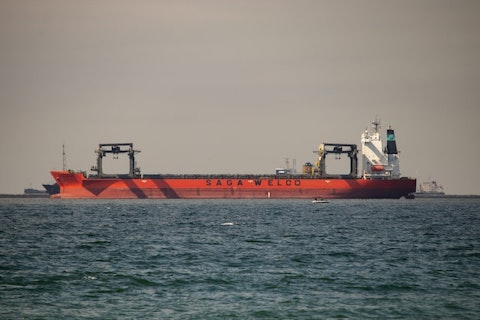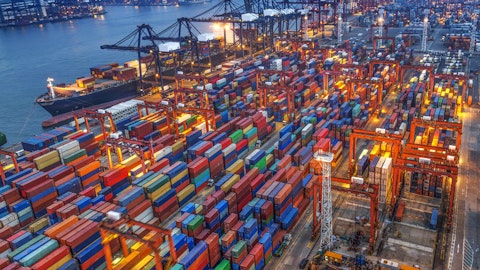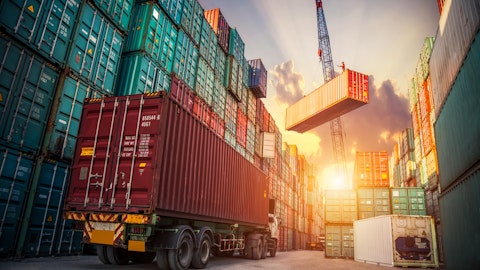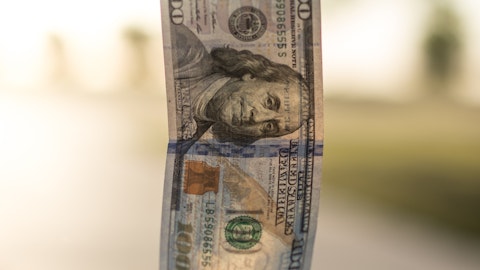Seanergy Maritime Holdings Corp. (NASDAQ:SHIP) Q4 2022 Earnings Call Transcript March 14, 2023
Operator: Thank you for standing by, ladies and gentlemen, and welcome to the Seanergy Maritime Holdings Corp. Conference Call on the Fourth Quarter and Year Ended 31 December, 2022 Financial Results. We have with us Mr. Stamatis Tsantanis, Chairman and CEO; and Mr. Stavros Gyftakis, Chief Financial Officer of Seanergy Maritime Holdings Corp. At this time, all participants are in listen-only mode. There will be a presentation, followed by a question-and-answer session. Please be advised that today’s conference is being recorded today, Tuesday, March 14, 2022. The archived webcast of the conference call accompanying slides will be soon made available on the Seanergy website, www.seanergymaritime.com. Please now turn to slide 2 of the presentation.
Many of the remarks today contain forward-looking statements based on the current expectations. Actual results may differ materially from the results projected from those forward-looking statements. Additional information concerning factors that can cause the actual results to differ materially from those in the forward-looking statements is contained in the fourth quarter and year ended December 31, 2022 earnings release, which is available on the Seanergy website, again. I would now like to turn the conference over to one of your speakers today, the Chairman and CEO of the company, Mr. Stamatis Tsantanis. Please go ahead, sir.
Stamatis Tsantanis: Thank you, operator. Hello. I would like to welcome everyone to our conference call. Today, we are presenting the financial results for the fourth quarter and the full year period of 2022. We are also pleased to announce the distribution of another cash dividend, which is basically equal to our net profit for the fourth quarter. The fourth quarter was another profitable period for Seanergy and concluded our second consecutive profitable year. First and foremost, in 2022, we clearly prioritize shareholder rewards, as I will discuss in detail in today’s call. We made generous distributions to our shareholders despite a series of macroeconomic and political challenges that occurred during the year. First, there was the invasion of Ukraine by Russia and the ongoing military conflict.
Second, the heightened uncertainty about the probability of a significant slowdown in the global economy due to the spike in inflation. Last but not least, 2022 marked the third consecutive year of severe lockdowns in China, which negatively affected industrial production and economic growth. However, the recent lifting of COVID-related lockdowns in China has already had a positive effect on general economic activity and steel production, and we expect to see accelerated raw material imports. We are bullish for the dry bulk market outlook, and we believe that Seanergy is very well-positioned to benefit over the next few years. Turning to our highlights. With regards to our financial performance, for the full year period, net revenue reached $125 million, adjusted EBITDA was $65.6 million, while net income amounted to $17.2 million.
As regards to fourth quarter, we recorded net revenues of $28.5 million and adjusted EBITDA of $12.5 million, while net income was equal to $0.5 million. Since the fourth quarter of 2021, we delivered approximately $58.4 million of value to our shareholders in the form of dividends, share buybacks and the repurchase of convertible securities. Our Board of Directors approved a cash dividend of $0.025 per share for the fourth quarter of 2022, which is effectively all of our net income. I’m confident that our financial performance will be able to support good shareholder returns throughout the shipping cycle. Regarding our vessel transactions, during 2022, we sold or spun out our three oldest vessels built in 2004, 2005 and 2006, while in the same period, we acquired two modern Japanese vessels, the Ownership built in 2010 and the scrubber-fitted Paroship built in 2012.
These transactions have a positive impact, both on our fleet’s average age as well as our profitability based on lower fuel consumption, better rating on the Baltic Capesize Index and scrubber premium earnings from the Paroship. During the second quarter of 2022, we concluded the spin-off of United Maritime Corporation, which commenced trading on Nasdaq Capital Market on July 6, 2022, under the symbol USEA. All shares of United were distributed to our shareholders. United in its first year of operations generated a significant profit and distributed massive dividend to its shareholders and hopefully, to Seanergy’s original shareholders that retained their United shares. In January 2023, we completed successfully the tender offer for Class E warrants, repurchasing approximately half of the outstanding securities, thus reducing dilution risk.
On February 16, 2023, very recently, we effected a 10:1 reverse split of our common stock and on the 3rd of March, we regained compliance with the Nasdaq’s minimum bid requirements. We expect the increase of the nominal price of our shares to have a positive effect on the marketability and trading liquidity, mainly by eliminating certain price-related trading restrictions. As regards to our financing updates, Synergy has completed new financings and refinancings of almost $125 million in 2022. We are also working closely on other deals that would improve further our financing costs and release liquidity. We are constantly working towards optimizing our capital structure and preserving our liquidity, while evaluating our options to refinance our indebtedness at lower interest rates.
Following up on our environmental, social and governance initiatives in 2022, we released our first ESG report, which provides an overview of our policies and commitments on ESG matters. Our Board of Directors has also established a sustainability committee with the aim of advising the board on relevant issues. We are guided by ESG principles in our operational and strategic objectives and we recognize the growing importance of these efforts in achieving the best outcomes for all companies, stakeholders and society. Lastly, given the large discount of our share price as compared to its intrinsic value, I have decided to personally purchase another up to $1 million in additional common shares. I intend to commence my purchases following the release of our earnings, which is now, in line with our internal trading policy and restrictions.
Turning to slide two for a more detailed breakdown of shareholder returns, approximately $18.5 million in regular dividends and $4.5 million in extraordinary dividends have been declared since the fourth quarter of 2021. This represents approximately 20% of our current market cap. Additionally, during the same period, a significant capital was deployed in the repurchases of shares and other potentially diluted securities. More specifically, $3.5 million has been allocated to share and warrant repurchases and $32 million was utilized to buy back convertible notes. On a final note, during 2022, our shareholders also received shares of our spin-off of United Maritime, which in turn, as I mentioned before, after a very profitable series of transactions, has made significant distributions to its shareholders.

Photo by Sven Piper on Unsplash
Since the initiation of our capital returns in the beginning of 2022, Seanergy has paid approximately $22.9 million in cash dividends, translating to $1.275 per share. When including the value of the United Maritime shares received as part of the spin-off, total distributions amount to approximately $1.61 per Seanergy share or a 26% dividend yield based on this by disclosing price. Please turn over to slide three to discuss our fleet’s commercial developments. Our fleet currently consists of 16 Capesize vessels with an average age of 12 years, of which nine have scrubbers installed. Our latest acquisition, the Paroship was placed into an index-linked time charter with a major European operator for a period of about 10 months. Additionally, following our last quarterly update, we completed the sales of two of our oldest vessels, the Tradership and Goodship build in 2005 and 2006, both vessels were delivered to their new owners in February of 2023.
As regards to our commercial performance, the daily time charter equivalent in the fourth quarter was approximately $17,300, representing a 16% premium to the average Baltic Capesize Index. In the full year period, we recorded a daily TCE of about $20,000 per ship per day or a 24% premium over the BCI. Our decision to focus on high-quality vessels and the scrubber premiums and by our fleet, in combination with some productive hedging through FFA conversions, have alleviated the effects of the falling spot market and we view this as an important validation of our commercial strategy. For the first quarter of 2023, we expect to earn daily time charter equivalent rate of $10,200, which may sound very low, but it’s a premium of more than 40% over the average BCI year-to-date.
In addition, we recently decided to convert the floating index-linked rates on two of our vessels to fixed rates at approximately $20,000 from the second quarter of 2023 until the end of the year. We are actively monitoring the FFA curve and considering further conversions as the market conditions and outlook improve. I will now pass the call to our CFO, who is going to discuss our financial results before I return to discuss our market update. Stavros, please go ahead.
Stavros Gyftakis: Thank you, Stamatis. Welcome, everyone, to our earnings call. Let us start by reviewing the main highlights of our financial statements for the fourth quarter and 12 months period that ended on December 31st, 2022. In the fourth quarter, we achieved net revenue of $28.5 million, reflecting increase from the net revenue of $56.7 million in the same period of 2021. The reduction in our revenue came as a result of the decline in the average daily time charter equivalent of fleet, which was mainly due to the increased volatility in spot earnings and the softer overall market conditions. Our adjusted EBITDA and net income stood at $12.5 million and $0.5 million, respectively. However, we remain profitable amid these unfavorable market conditions.
And in fact, we were able to outpace the market as this is reflected in the Baltic Capesize Index. For the 12-month period, net revenue was $125 million with our average daily time charter equivalent rate standing at $20,040 compared to net revenue of $153 million, and an average daily time charter equivalent rate of $27,400 last year. Net income for the 12-month period was $17.2 million, while adjusted EBITDA reached $65.6 million. Earnings per share for the quarter and 12-month period were $0.03 and $0.97 respectively. Concerning our balance sheet, our cash at the end of the fourth quarter remained robust and stood at $32.5 million, in a year with approximately $28 million in dividend distributions and buybacks. At the same time, our assets sold to $514 million, while our debt also increased but remained at modest levels as it is reflected in our debt ratio of approximately 51%.
Our net debt at the end of the year was $227.4 million. Finally, total shareholders’ equity was $222 million as of December 31, 2022, from $245 million at the end of 2021. Overall, and given the softer Capesize market, we witnessed in the second half of the year, our performance was satisfied with TCE and adjusted EBITDA outpacing our average performance over the last five years. The effective deployment of our corporate and commercial strategies allowed us to retain an adjusted EBITDA margin of 51.6%, just 5% below the record margin achieved in 2021. As regards to our operating expenses, we note it arise in 2022, due to the high inflationary environment. Our average daily operating expenses excluding pre-delivery expenses, was $6,819, reflecting a 10% increase compared to the previous year.
However, with most of our fleet now being managed in-house and with increased efficiency that we have seen as of late, we expect these expenses to be change in the coming year. Moving on to our debt profile and some details on our financing updates. The senior debt outstanding at the end of 2022 was $249 million, which translates to $13.8 million per vessel, secured against an average market value per vessel of about $25.4 million in a year that we accomplished the partial renewal of our fleet, we managed to retain our corporate leverage at modest levels at around 53%, despite the market values correcting by approximately 25% during the second half of the year. Additionally, during 2022, we completed a $10 million buyback of convertible notes, while another $8 million were repaid in the beginning of this year.
Meanwhile, decrease was noted in our cash interest and finance expenses in 2022, which reached $10.8 million versus $11 million in the previous year. This becomes even more remarkable, considering the sharp tightening of Fed interest rate a sheer 400 basis point increase during the period. Our efforts to improve the overall terms of our facilities continued this year with total financing and refinancing of $124.8 million, with the average margin of our facilities dropping further to 2.9% as of December 31, 2022 versus 3.2% the year before. I would now move on to discuss the financing transactions that have taken place since our last update in more detail. In December, we entered a $16.5 million loan facility with our existing lender, Alpha Bank to finance part of the acquisition cost of our late Capesize, the Paroship.
The facility has a term of four years, while the interest rate is 2.9% plus SOFR and will amortize through four quarterly installments of $0.5 million, followed by 12 quarterly installments of $400,000 and a $9.6 million balloon payment at maturity. Meanwhile, in connection with the recent sale of Goodship and Tradership, the company prepaid on February, the $12.9 million outstanding on the AB Bank facility, which was secured by these two vessels. In addition to this transaction, the company has recently obtained one commitment letter from one of our existing lenders, Danish Finance for a loan facility of up to $15.8 million. The support of our banks is apparent even in today’s volatile market conditions. This facility will be used to partly finance the repurchase of the Championship currently under sale and leaseback with Cargill.
With this transaction, we will not have any debt maturities until the second quarter of 2025. The loan will bear interest at a rate of 2.65% plus SOFR adjusted annually subject to the achievement of certain carbon emissions targets and the term of the agreement will be five years. Moreover, we are in progress discussions for a sale and leaseback transaction of up to $19 million in order to refinance at improved terms an existing sale and leaseback agreement for line of fact 2010 built Capes. Moving on and before returning the call back to Stamatis, I would like to discuss our operating leverage and some guidance for our company’s performance on charter rates have been stabilized at healthier levels. The potential for higher EBITDA in 2023 is clear, as it is illustrated in the graph we’ve seen.
Even freight settled this year at the same numbers as in 2022, we expect our EBITDA to overcome the $60 million, while it’s a great year of 2021 is repeated our projection showing EBITDA of $148 million. At recent point in the year, these projections are obviously subject to significant uncertainty, but the increase in potential profitability is clear. This concludes my review. I will now turn the call back to Stamatis, who will discuss the market and industry fundamentals. Stamatis?
Stamatis Tsantanis: Thank you, Stavros. Let’s now elaborate on the Capesize demand and supply fundamentals. In 2022, the Capsize market started off with a strong first half and ended on a weaker Q3 and Q4, diverging from the usual historical pattern. As discussed at the beginning of this call, the global picture was negatively affected by the invasion of Ukraine by Russia and the ongoing military contract. In addition, rising inflation had a negative impact on the global economy by increasing the uncertainty in industrial input costs. Lastly, 2022 was the third consecutive year of lockdowns in China, which resulted in a negative economic backdrop, punctuated by fully industrial production and economic growth. The average level of the Baltic Capesize Index for the year 2022 was approximately 16,200, with a first half average of 18,200 and the second half average of 14,300.
We’re pleased to see the market achieve these levels amidst slower industrial activity, and we are confident of further improvements as conditions normalize. Let’s discuss now the high level demand and supply picture for 2023 and onwards. In terms of vessel demand during 2022, China’s industrial production fell, due to squeeze profit margins and weaker real estate activity. The manufacturing purchasing managers’ index fell to its lowest level since the COVID lockdowns and to the second lowest level since 2010. So far in 2023, we have seen a reversal of these negative trends, as the latest two months manufacturing PMI in China registered the highest increases of the past 10 years. Other forward-looking indicators, such as excavator sales, which have historically been good predictors of future construction activity have also turned upwards, while profit margins and utilization for steel mills are rebounding strongly and Brazilian iron ore exports are finally back on track for a better performance.
This supported both from incremental improvements in the real estate construction and car production among others. Aside from China, we expect a massive infrastructure projects in the Middle East area, which are in excess of US$1.5 trillion until 2030, as well as India’s accelerated economic growth rate to be key factors for raw material demand. Moving on to vessel supply. Figures are very encouraging for the Capesize sector. First, the current new vessel order book is at the lowest point in decades. The combination of high steel prices and high interest rates, directly reduces the incentive for new vessel orders, while limited shipyard capacity would make it almost impossible to get a new vessels delivered before the end of 2025 at best. As regards to demolition, high scrap prices are likely to incentivize the continued demolition of ineffective tonnage over the next years, especially as stricter environmental regulations set in, along with the potential for fleet speed reduction due to EEXI and CII, the new regulations, the effective Capesize fleet capacity will be firmly under control or even reduce in the coming years.
Concluding, as a closing remark, I’m pleased with our financial performance during a very volatile year for the Capesize market. We are consistent to our pledge to deliver strong shareholder returns by executing significant distributions and creating significant accretion. Synergy remains in an excellent position to capitalize on the expected strong markets in the next years. On that note, I would like to turn the call over to the operator and answer any questions you may have. Operator, please take the call. Thank you.
See also 14 Best Falling Stocks To Buy Now and 12 Best US Chemical Stocks To Buy Now.
Q&A Session
Follow Seanergy Maritime Holdings Corp
Follow Seanergy Maritime Holdings Corp
Operator: And the first question from Tate Sullivan from Maxim Group. Please go ahead.
Tate Sullivan: Hello. Thank you. Good day Stamatis and Stavros. Stamatis, you commented on supporting good shareholder returns through the cycles and I think, correct me if I’m wrong, I think you’ll have a gain on the sale of about $8 million in this current quarter from selling two vessels. I mean how do you consider that gain when you evaluate your quarterly dividend since it is a one-time? And just another way what the dividend amount that you announced today as well please?
Stamatis Tsantanis: Hi Tate, good morning and thanks for the question. Well, obviously, yes, we’re going to have a gain from the sale of the ships. At the same time, Q1 so far has been trading at around $10,000 a day. So, we have to see what’s going to be the final impact from that at the end of the quarter and then we will decide. But it’s not going to be a static approach if obviously, the market has turned to where we wanted to go and where it appears that it is going. Then obviously we will try and reward our shareholders more generously to put it this way. Right now, the reduction of the dividend has been in order to reflect the very bad market that we experienced in Q1 or we are experiencing so far. And we’re trying to preserve cash and liquidity as much as we can. Obviously, as things change in the future and as things improve, we have had an excellent track record in paying out to our shareholders to the best of our capacity.
Tate Sullivan: Thank you. Yes. And you mentioned the repurchases — and I mean the China PMI reading a couple of weeks ago was the highest what 2012, but then — I mean, since that PMI reading, have you seen or even before that, China booking more voyages? Are there any other tangible data points that you can point to in terms of China demand for the dry bulk sector, please?
Stamatis Tsantanis: Demand is not only China-driven. I mean we keep saying China and China, but I think China contributed more to the negative market of 2022. And we believe it’s going to contribute a lot in the upside. But have in mind that China and the PMI was so weak in 2022 because they had the third consecutive year of almost a full year lockdown. As you can understand, this had a severe impact in industrial production, things start to turn very . At the same time, it’s not only the vast infrastructure projects that we expect to happen in the Far East area. We also see that there’s going to be $1.5 trillion of new infrastructure investments in the UAE area, together with Saudi Arabia that have already started. So, this is going to absorb a lot of steel and a lot of iron ore and coking coal demand in our opinion.
So, overall, we feel that the market is getting into a very strong infrastructure phase. Combined with the Chinese reopening of the economy, I believe that from a demand perspective, we will see much, much better numbers than compared to last year.
Tate Sullivan: Thank you. And Stavros further, I’m looking at the numbers, but can you remind me the fees from related parties. Is that related to United Maritime or some gain on bunker fuel, or is the gain on bunker fuel within the lower operating expenses?





